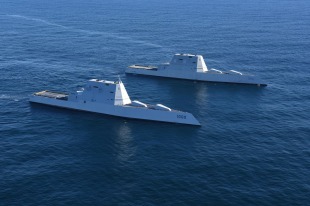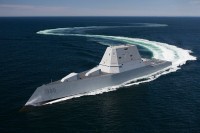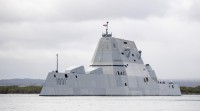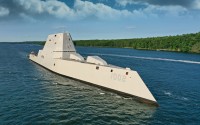Zumwalt-class destroyer
Basic information
Ship measurements
Machine
- 2 * Rolls-Royce MT30 gas turbines (35.4 MW) driving Curtiss-Wright electric generators
- 2 * Rolls-Royce RR4500 turbine generators (3.8 MW)
- 2 * propellers driven by GE Power Conversion Advanced Induction Motors with VDM25000 Drive
- Total 78 MW (105,000 shp)
Personnel
Combat assets
- AN/SPY-3 Multi-Function Radar (MFR) (X band active electronically scanned array)
- 20 * MK 57 VLS modules, 4 cells per module, 80 launch cells total
- 320 * RIM-162 Evolved Sea Sparrow Missile (ESSM), 4 per cell
- 80 * Tactical Tomahawk, 1 per cell
- 80 * Vertical Launch Anti-Submarine Missile (ASROC), 1 per cell
- 2 * 155 mm (6 in)/62 caliber Advanced Gun System
- 2 * 30 mm (1.2 in) Mk 46 Mod 2 Gun Weapon System
- 1 * SH-60 LAMPS or MH-60R helicopter
- 3 * MQ-8 Fire Scout VT-UAVs
The Zumwalt-class destroyer is a class of three United States Navy guided missile destroyers designed as multi-mission stealth ships with a focus on land attack. It is a multi-role class that was designed for secondary roles of surface warfare and anti-aircraft warfare and originally designed with a primary role of naval gunfire support. It was intended to take the place of battleships in meeting a congressional mandate for naval fire support.
These ships are classed as destroyers, but they are much larger than any other active destroyer or cruiser. The vessels' distinctive appearance results from the design requirement for a low radar cross-section. The Zumwalt-class has a wave-piercing tumblehome hull form whose sides slope inward above the waterline, which dramatically reduces radar cross-section by returning much less energy than a conventional flare hull form.
The Zumwalt-class has an integrated power system that can send electricity from its turbo-generators to the electric drive motors or weapons, the Total Ship Computing Environment Infrastructure, automated fire-fighting systems, and automated piping rupture isolation. The class is designed to require a smaller crew and to be less expensive to operate than comparable warships.
The lead ship number DDG-1000 is named Zumwalt. Originally, 32 ships were planned, with $9.6 billion research and development costs spread across the class. As costs overran estimates, the quantity was reduced to 24, then to 7, and finally to 3, significantly increasing the cost per ship to $4.24 billion and well exceeding the per-unit cost of a nuclear-powered Virginia-class submarine ($2.688 billion).
The tumblehome hull and composite deckhouse reduce radar return. Overall, the destroyer's angular build makes it 50 times harder to spot on radar than an ordinary destroyer.
The acoustic signature is comparable to that of the Los Angeles-class submarines. Water sleeting along the sides, along with passive cool air induction in the mack, reduces infrared signature. The composite deckhouse encloses much of the sensors and electronics.
The «Zumwalts» use an Integrated Power System (IPS), which is a modern version of a Turbo-electric drive system. The IPS is a dual system, with each half consisting of a gas turbine prime mover directly coupled to an electrical generator, which in turn provides power for an electric motor that drives a propeller shaft. The system is «integrated» because the turbo-generators provide electrical power for all ship systems, not just the drive motors. The system provides much more available electrical power than is available in other types of ship.
Automation reduces crew size on these ships: the Zumwalt-class destroyer's minimum complement is 130, less than half of needed by «similar warships». Smaller crews reduce a major component of operating costs. Ammunition, food, and other stores are all mounted in containers able to be struck below to magazine/storage areas by an automated cargo handling system.
The Zumwalt-class destroyer is not an Aegis system. It uses instead the class-unique Total Ship Computing Environment Infrastructure (TSCEI) integrated mission system. The peripheral vertical launch system (PVLS) is capable of accommodating all Standard missile types.
Ships3
- Comments
 en
en ru
ru uk
uk





 United States Navy
United States Navy Bath Iron Works (BIW)
Bath Iron Works (BIW)

